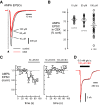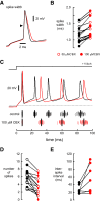Direct actions of carbenoxolone on synaptic transmission and neuronal membrane properties
- PMID: 19535488
- PMCID: PMC2724329
- DOI: 10.1152/jn.00060.2009
Direct actions of carbenoxolone on synaptic transmission and neuronal membrane properties
Abstract
The increased appreciation of electrical coupling between neurons has led to many studies examining the role of gap junctions in synaptic and network activity. Although the gap junctional blocker carbenoxolone (CBX) is effective in reducing electrical coupling, it may have other actions as well. To study the non-gap junctional effects of CBX on synaptic transmission, we recorded from mouse hippocampal neurons cultured on glial micro-islands. This recording configuration allowed us to stimulate and record excitatory postsynaptic currents (EPSCs) or inhibitory postsynaptic currents (IPSCs) in the same neuron or pairs of neurons. CBX irreversibly reduced evoked alpha-amino-3-hydroxy-5-methyl-4-isoxazole-proprionic acid (AMPA) receptor-mediated EPSCs. Consistent with a presynaptic site of action, CBX had no effect on glutamate-evoked whole cell currents and increased the paired-pulse ratio of AMPA and N-methyl-d-aspartate (NMDA) receptor-mediated EPSCs. CBX also reversibly reduced GABA(A) receptor-mediated IPSCs, increased the action potential width, and reduced the action potential firing rate. Our results indicate CBX broadly affects several neuronal membrane conductances independent of its effects on gap junctions. Thus effects of carbenoxolone on network activity cannot be interpreted as resulting from specific block of gap junctions.
Figures




Similar articles
-
Carbenoxolone blockade of neuronal network activity in culture is not mediated by an action on gap junctions.J Physiol. 2003 Dec 15;553(Pt 3):729-45. doi: 10.1113/jphysiol.2003.053439. Epub 2003 Sep 26. J Physiol. 2003. PMID: 14514879 Free PMC article.
-
Presynaptic inhibition preferentially reduces in NMDA receptor-mediated component of transmission in rat midbrain dopamine neurons.Br J Pharmacol. 1999 Jul;127(6):1422-30. doi: 10.1038/sj.bjp.0702680. Br J Pharmacol. 1999. PMID: 10455292 Free PMC article.
-
Enflurane directly depresses glutamate AMPA and NMDA currents in mouse spinal cord motor neurons independent of actions on GABAA or glycine receptors.Anesthesiology. 2000 Oct;93(4):1075-84. doi: 10.1097/00000542-200010000-00032. Anesthesiology. 2000. PMID: 11020764
-
Metabotropic glutamate receptors modulate glutamatergic and GABAergic synaptic transmission in the central nucleus of the inferior colliculus.Brain Res. 2010 Apr 14;1325:28-40. doi: 10.1016/j.brainres.2010.02.021. Epub 2010 Feb 11. Brain Res. 2010. PMID: 20153735
-
How addictive drugs disrupt presynaptic dopamine neurotransmission.Neuron. 2011 Feb 24;69(4):628-49. doi: 10.1016/j.neuron.2011.02.010. Neuron. 2011. PMID: 21338876 Free PMC article. Review.
Cited by
-
Vascular Gap Junctions Contribute to Forepaw Stimulation-Induced Vasodilation Differentially in the Pial and Penetrating Arteries in Isoflurane-Anesthetized Rats.Front Mol Neurosci. 2018 Dec 3;11:446. doi: 10.3389/fnmol.2018.00446. eCollection 2018. Front Mol Neurosci. 2018. PMID: 30559647 Free PMC article.
-
Connexins in Cardiovascular and Neurovascular Health and Disease: Pharmacological Implications.Pharmacol Rev. 2017 Oct;69(4):396-478. doi: 10.1124/pr.115.012062. Pharmacol Rev. 2017. PMID: 28931622 Free PMC article. Review.
-
Spontaneous activity in the developing gerbil auditory cortex in vivo involves GABAergic transmission.Neuroscience. 2012 Dec 13;226:130-44. doi: 10.1016/j.neuroscience.2012.09.008. Epub 2012 Sep 15. Neuroscience. 2012. PMID: 22986170 Free PMC article.
-
Mice Lacking Pannexin 1 Release ATP and Respond Normally to All Taste Qualities.Chem Senses. 2015 Sep;40(7):461-7. doi: 10.1093/chemse/bjv034. Epub 2015 Jul 1. Chem Senses. 2015. PMID: 26136251 Free PMC article.
-
Connexin 43 Differentially Regulates Epileptiform Activity in Models of Convulsive and Non-convulsive Epilepsies.Front Cell Neurosci. 2019 May 10;13:173. doi: 10.3389/fncel.2019.00173. eCollection 2019. Front Cell Neurosci. 2019. PMID: 31133805 Free PMC article.
References
-
- Bekkers JM, Stevens CF. NMDA and non-NMDA receptors are co-localized at individual excitatory synapses in cultured rat hippocampus. Nature 341: 230–233, 1989. - PubMed
-
- Chepkova AN, Sergeeva OA, Haas HL. Carbenoxolone impairs LTP and blocks NMDA receptors in murine hippocampus. Neuropharmacology 55: 139–147, 2008. - PubMed
-
- Connors BW, Long MA. Electrical synapses in the mammalian brain. Annu Rev Neurosci 27: 393–418, 2004. - PubMed
Publication types
MeSH terms
Substances
Grants and funding
LinkOut - more resources
Full Text Sources
Miscellaneous

